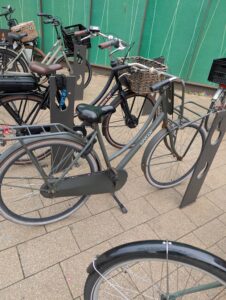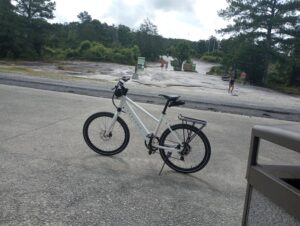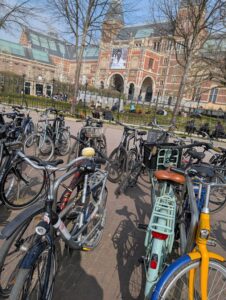 There is an enormous amount of confusion on the “fietspads” of Europe and the bike paths of America.
There is an enormous amount of confusion on the “fietspads” of Europe and the bike paths of America.
Much of it is caused by confusion over what we mean by a bike.
Dutch cycling starts with a simple bike called an “Oma Fiets,” like the one here. You sit upright, your weight on your backside, with full visibility in any direction. You can’t go fast, and you can’t go far. But if you live in what’s called a “walkable” neighborhood, you can get your groceries, take the grandkids to school, and do other chores.
Oma Fiets needs infrastructure to work. It needs dense development, and safe bike paths.
Current models have seven gears, changed with a click on the right side of the handlebars. The left side often has a bell, which you tap to let people know you’re behind them. The brakes can be operated by hand or by foot. You can get a good one for under $100, and there is a shop around every Netherlands corner that will rent one to you, and where you can get a quick repair.
Opa Fiets

The battery is in the downtube, and it’s removable so the bike need not come inside. There are three power levels, located near the gear lever, managed by buttons. Other than that, it’s the same bike.
That’s why I call this the Opa Fiets.
Like its human-powered mate, the Opa Fiets is limited to 25 kph, or 15 miles per hour, under motor power. Usually, it goes much slower than that, because of traffic. I’ve been averaging 15 kph, or 10 mph.
Because of the way you ride it, with all the weight on your backside, it’s foolish to go very far, and most trips on such a bike are 5 km (3 miles) or less. (More fool me.) The hard saddle of the Dutch e-bike helps emphasize the point of its short range, which is why I borrowed a soft saddle from a friend. Everyone insists the saddle is for women, too. Too bad. If Opa Fiets is going to ride 30 miles (45 km) in a day, then Opa Fiets needs his comfort.
American Bikes

I once did a century on my Romic, with 12 gears and a hard leather Brooks saddle, but it’s not designed for chores. It’s designed for exercise. Road bikers here in the Netherlands easily do 40 km (25 miles) in the morning, then stop for coffee or a beer before riding home. So, too, with their American counterparts.
Edison

It’s based on a mountain bike design, so while you’re mainly upright, there is a forward lean to it. Some weight rests on your hands and some rests between your legs. Some is also on your feet, important given bumpy Atlanta roads with potholes from trucks and uneven pavement from repairs to the water lines. Commercial roads that would make great fietspads, like Highland Ave., are washer boards, worse than the Belgian cobbles.
There are other differences between these two electrics. The Edison has a throttle, just enough power to get me started. I miss it on Opa Fiets.
The motor can get me up to 20 mph (32 kph) before cutting out. But there are downhills within a mile of my house where I can freewheel at 30 mph (48 kph) comfortably, which keeps this old man feeling young and has my wife’s hair going gray. The brakes are all on the wheel so there are two brake levers. The power controls are in such easy reach, it was months before I started using the gears.
While there are many American e-bikes with external batteries you can take off and charge indoors, I bring the Edison inside to charge it from a 110-volt wall plug. I seldom go out in the rain, and when I do I rub everything down with a towel before coming in.
Dutch vs. American Fietsing

This doesn’t mean Dutch cyclists don’t have helmets. I learned coming back from the Flower Parade that most riders my age do. There’s also a campaign to get kids to wear helmets. But the whole concept of Dutch cycling is to get where you want with minimal fuss and expense. It’s fietsing, not bicycling.
It works because Dutch bikes are designed for dense cities. Most single-family houses are built as townhome blocks, and many people live in apartments. Before even a four-story building is erected on the muddy soil, footings are drilled deep into the ground. It looks like they’re drilling for oil. That’s another reason for density. Construction is always expensive.
In Atlanta, you can easily build four stories of sticks from just a cement pad, and if you use steel beams for the ground floor shops, with their high ceilings, you can get up to 5 stories. Build a parking deck against the building and you can get higher still, with parking and tenant elevators sharing the scheme.
But these buildings are exceptional, often near major intersections, because again it’s assumed everyone has a car. If everyone expects a 50 x 100 lot (7 by 14 meters) or larger lot one day, you can’t have the kind of population density needed to make Dutch cycling work, or even American fietsing.
Beyond the Edison

Mobility scooters here can go as fast as Opa Fiets. There are electric trikes for those who need that margin of safety. Little kids and big loads ride in cargo bikes like the Urban Arrow. There are also e-bikes used for deliveries in major cities. It’s an extra layer of distribution for companies like Amazon, but they save on the last mile.
Thousands of kids around Utrecht now have “Class 3” e-bikes, called “fat tires” here. They’re short, they’re black, they’re unregulated, and they can easily go 28 mph (45 kph) with minimal effort. They’re a hazard, the kids are riding without helmets, but many adults are now using them, and the country needs to figure out what to do about them, because if nothing is done, they’re taking over.
In Asia, where you can’t be certain how far you need to ride, and where both sidewalks and roads are impassable by bikes, electric mopeds have become a dominant form of transportation. They’re faster than e-bikes, slower than motorcycles, and travel 100 miles between charges. Some makers recharge by swapping out the batteries, faster than you can gas up your car at Buc-ees.
Terrors of the Fietspad

They’re not supposed to be on the fietspad, but they’re there anyway. The drivers are licensed, helmets are mandatory, they regularly blow by me at 40 mph (65 kph). They’re smelly, they’re noisy, they’re horrible, and if you’re outside the city, even a little bit, they’re everywhere. The riders know what they’re doing, crossing between auto route and fietspad at will. It will take some will to make them stop. I wonder if the Dutch have it.
Motorcycles have it over their electric cousins because they have twice the range, about 200 miles. Someone recently showed off an electric motorbike with almost 200 miles of range, but that’s exceptional and expensive.
As the next generation of batteries takes over the market, with greater energy density than today’s Lithium-Ion models, ranges and speeds for e-transport will both increase. That’s when we really need to worry, when electric motorbikes are coming up behind you on the Dutch fietspad, and when they’re bringing you your take-out meals in Atlanta.










